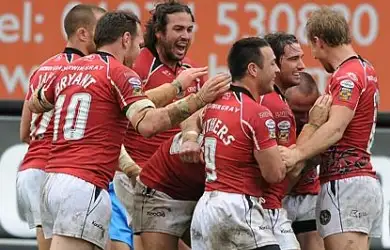The Super League Revolution – Part 4

The inception of Super League had brought with it a flurry of changes and improvements off the pitch, as we have seen. What of the product on the field though?
Many had suggested that the increased TV coverage, and the sport’s growing dependence on the revenue this generated, would result in matches being divided into four 20-minute quarters, a concept which looks likely to be introduced in the USA’s embryonic AMNRL competition. Other proposals included the introduction of a ‘golden point’ period of extra-time if the two teams are level after 80 minutes, a system which has been adopted by the Australian NRL.
Neither of these ideas have attracted the support required for them to be given serious consideration on these shores though.
One innovation that has been implemented during the Super League era, however, is the 40/20. The 40/20 gives the attacking team the opportunity to earn a repeat set in opposition territory if they can successfully find touch inside their opponent’s 20 metre zone with a punt from inside their own 40. The rule gives teams the chance to turn the momentum of a game on its head and adds that element of unpredictability to matches which makes compelling viewing.
Another rule change brought about by Super League dictates that the team conceding a try restarts the game, a rule which favours teams attempting to mount a comeback. The zero tackle rule was also introduced in ’98 and grants the the team in possession an extra tackle following an opponent’s handling error.
Whist it was a change in the rules that brought about the introduction of the 40/20 and zero tackle, the decline of the competitive scrum has been a by-product of the sport’s evolution during the summer era. Gone are the days of a scramble in the ruck to win possession for your side that characterised forward play right up until to the mid-nineties. By the turn of the century, scrums involved little more than a touching of shoulders whilst the ball was whipped around the loose forward’s legs and out to the wings in a matter of seconds. Many argue that the concept of the scrum is now redundant and the game should instead be restarted with a tap, it’s difficult to reason otherwise.
Globally, Rugby League has become known for it’s willingness to innovate if it feels a change would benefit the sport. Barely a year goes by without the RFL attempting to evolve and modernise the sport and it’s this willingness to evolve that has helped turn Rugby League into a dynamic, unpredictable spectacle that’s tailor-made made for TV. We shouldn’t forget this.
By 2002, Super League crowds were around the 7,000 mark with the likes of Leeds, Bradford and Wigan continuing to lead the way. Perennial strugglers Huddersfield, whose place in Super League had only been preserved by the RFL’s desire to keep their state of the art stadium in the elite division, were relegated at the end of 2001 and took their place in the NFP. The men from the McAlpine had won just 17 matches in 4 Super League years, but a season in the wilderness did them the world of good. They remained full-time and finished the campaign unbeaten to seal an immediate return to the top flight. Since rejoining Super League in 2003, the Giants have improved year on year and have reached 2 out of the last 4 Challenge Cup finals.
Super League VII was won by St. Helens, who also topped the division following the regular season. The men from Knowsley road were edged out in the Cup final though by arch-rivals Wigan, who have yet to appear in the cup final since. 2003 was the year of the Bull with Brian Noble’s Bradford becoming the first ever side to complete the double and clinch both the Super League Trophy and Challenge Cup.